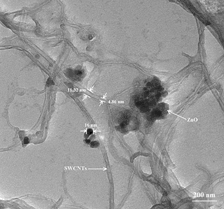Crossref Citations
This article has been cited by the following publications. This list is generated based on data provided by
Crossref.
Abdullah, H.
Omar, A.
Razali, M. Z.
and
Yarmo, M. A.
2014.
Photovoltaic properties of ZnO photoanode incorporating with CNTs for dye-sensitized solar cell application.
Ionics,
Vol. 20,
Issue. 7,
p.
1023.
Abdullah, Huda
Mahalingam, Savisha
Omar, Azimah
Razali, Mohd Zikri
Shaari, Sahbudin
and
Asshaari, Izamarlina
2014.
Platinum-Incorporating Graphene Counter Electrode for In<sub>2</sub>O<sub>3</sub>-Based DSSC with Various Annealing Temperatures.
Advanced Materials Research,
Vol. 911,
Issue. ,
p.
266.
Hu, Jing
Xie, Yahong
Bai, Te
Zhang, Chunyang
and
Wang, Jide
2015.
A novel triple-layer zinc oxide/carbon nanotube architecture for dye-sensitized solar cells with excellent power conversion efficiency.
Journal of Power Sources,
Vol. 286,
Issue. ,
p.
175.
Song, Lixin
Du, Pingfan
Xiong, Jie
Ko, Frank
and
Cui, Can
2015.
Efficiency enhancement of dye-sensitized solar cells by optimization of electrospun ZnO nanowire/nanoparticle hybrid photoanode and combined modification.
Electrochimica Acta,
Vol. 163,
Issue. ,
p.
330.
Mahalingam, Savisha
Abdullah, Huda
Shaari, Sahbudin
and
Muchtar, Andanastuti
2016.
Improved catalytic activity of Pt/rGO counter electrode in In2O3-based DSSC.
Ionics,
Vol. 22,
Issue. 12,
p.
2487.
Mallakpour, Shadpour
and
Khadem, Elham
2016.
Carbon nanotube–metal oxide nanocomposites: Fabrication, properties and applications.
Chemical Engineering Journal,
Vol. 302,
Issue. ,
p.
344.
Khan, M.Z.H.
Al-Mamun, M.R.
Halder, P.K.
and
Aziz, M.A.
2017.
Performance improvement of modified dye-sensitized solar cells.
Renewable and Sustainable Energy Reviews,
Vol. 71,
Issue. ,
p.
602.
Noor Azmy, Noor Azwen
A. Bakar, Ahmad Ashrif
Arsad, Norhana
Idris, Sarada
Mohmad, Abdul Rahman
and
Abdul Hamid, Aidil
2017.
Enhancement of ZnO-rGO nanocomposite thin films by gamma radiation for E. coli sensor.
Applied Surface Science,
Vol. 392,
Issue. ,
p.
1134.
Efa, Mulugeta Tesema
and
Imae, Toyoko
2019.
Effects of carbon dots on ZnO nanoparticle-based dye-sensitized solar cells.
Electrochimica Acta,
Vol. 303,
Issue. ,
p.
204.
Idris, M. I.
Abidin, Yasmin Zainol
Abdullah, Huda
Shafie, S.
Chachuli, Siti Amaniah Mohd
Rashid, M.
and
Xian, K. J.
2020.
Zinc Oxide Quantum Dots as Photoanode for Dye-Sensitized Solar Cell.
p.
57.
Wang, Dengjun
Sun, Wenjie
and
Su, Chunming
2020.
Metal Oxide Nanocomposites.
p.
73.
Sharma, Sugandha
Tomar, Monika
Gupta, Vinay
and
Kapoor, Avinashi
2021.
Investigation of cadmium-incorporated ZnO thin films for photodetector applications.
Superlattices and Microstructures,
Vol. 151,
Issue. ,
p.
106812.
Riaz, Sara
Aman, Yann
Nasir, Muhammad
Hayat, Akhtar
and
Hasnain Nawaz, Mian
2022.
Metal Oxide-Carbon Hybrid Materials.
p.
61.
